I just finished my planting for this year. Normally I plant from the time that nurseries open to the time they close and if you’d asked me the first week of November, I would have said that I was done for the year and ready to concentrate on art and writing, including the Florilegium, which I launched in mid-October along with the general site redesign. Now, I was fully prepared for the last major construction project of the house, rebuilding our lower deck, in the latter part of October. As with all things in our house, this required my constant attention, but in the end, it turned out well, a major improvement over the wreck that had been there. With the deck complete, I went out and bought plants from my friends at Gino’s Nursery. To my dismay, the new management at Bowman’s Hill not only raised their prices substantially this year but also didn’t have an end-of-the-year sale, which meant I bought almost nothing from them in the fall and their tables were full of plants whereas Gino’s lot was near empty. I swiftly got those in the ground, helped Liam get his college applications out (he got into NYU, we found out last week, so it was worth it) and immediately went down for a week after having contracted my first real respiratory illness since 2019, a common cold. After I was well, I spent some time cleaning up the garden, took care of some business, and then, two days before Veterans Day, received a notice from Montclair Township that “curbing” would begin the next week. No surprise, the letter was poorly worded and vague about what would take place. Communication is something the town does grudgingly and without enthusiasm. My pleas for more information from the town went unheeded and, although the letter stated that curbing would consist only of spot replacement of deteriorated areas of concrete curbs, upon talking with the workmen, we learned that this would involve the replacement of all of the curbs with Belgian Block. I am not a fan of Belgian Block. It doesn’t look as modern as a concrete curb and it causes road rash to alloy rims on cars. It is less permeable to water than concrete (!) and looks like something an escapee from the “Desperate Housewives of New Jersey” would demand. But we were not consulted and there were no options here. It turned out that 2 to 3′ of soil abutting the curb along the entire 146′ front of our property would be excavated—about half of the roadside native plant garden at Highland House—would be removed. Crisis yet again.
Running along the First Watchung Mountain, Highland Avenue is the highest elevation road in this part of town and is frequently visited by walkers and drivers in search of distant views of the city and as much woodland as one can find in this town. So when I began the process of landscaping the property myself in 2016, I started at the street front, the public façade that this garden presents. A gardener’s approach to the street front is a clue to the general approach the gardener takes to the property, so it must be considered.
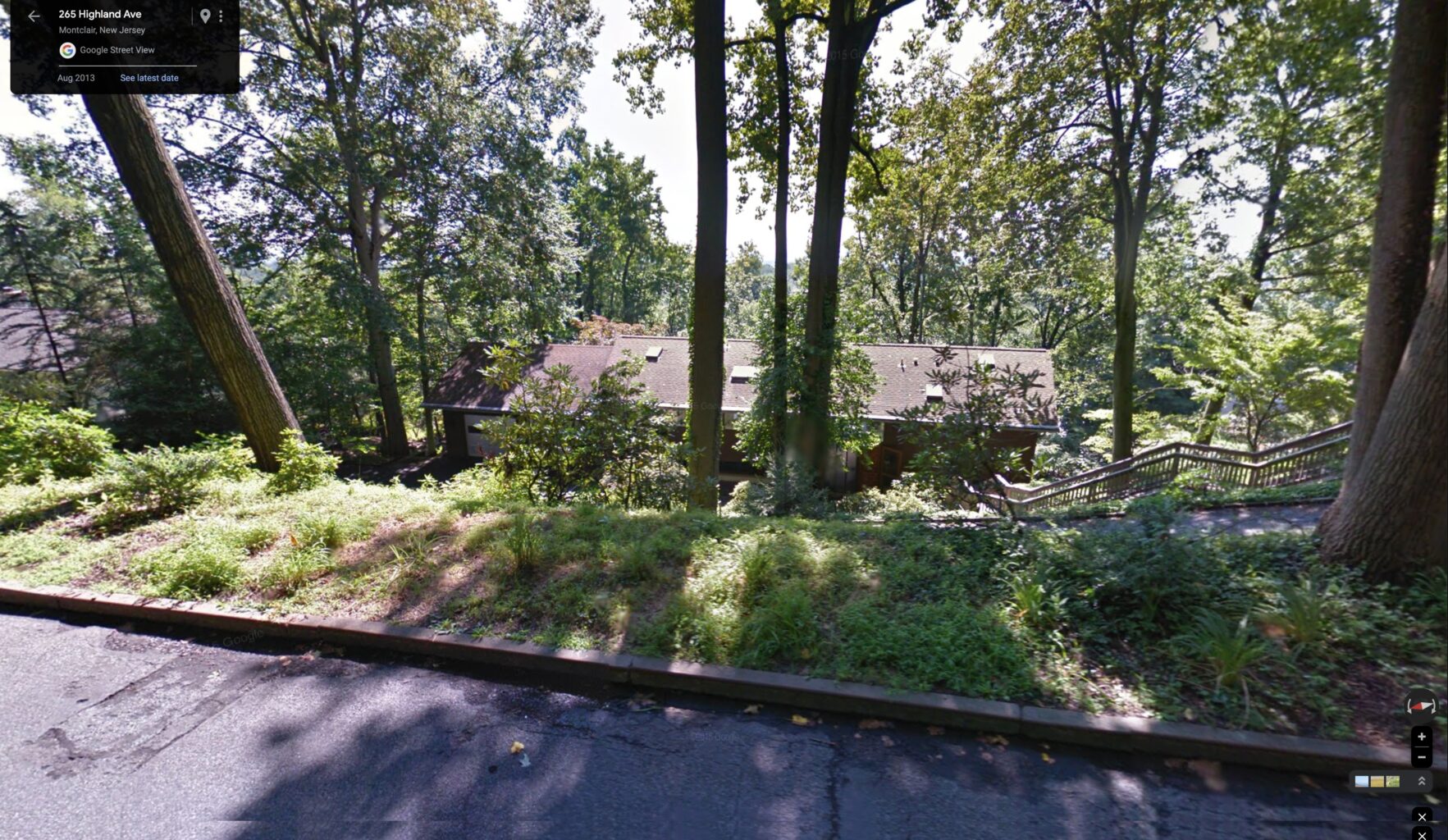
Like the rest of my yard, the streetfront was largely barren and neglected before we moved in. The previous owners were suckered into removing the leaves off the landscape to put them in bags for the town to haul away like so much used underwear. Because all of the ground’s riches were being stolen by the town or extorted by landscapers every year, all that was left was a very hard, compacted soil that would not hold water well and was virtually impervious to a shovel. As you can see in this Google Street View image from August, 2013, the only plants that thrived were invasive weeds, sad-looking deer-eaten hostas, invasive ditch-lilies (that never bloomed), and one sorry-looking Ilex crenata, a Japanese bush commonly found in the nursery at Home Depot and in office parks. Welcome to a mess.
My first effort with landscape was at the top of the road but swiftly failed. I knew we wanted to plant native plants, but I also knew nothing about gardening or landscape apart from experience growing vegetables, something that was not possible with the heavy deer browse in our area. So, in fall 2014, I employed a local landscape company that billed itself as sensitive to the environment. Thousands of dollars later, the project was done, but virtually nothing survived to the next year. It cost a lot of money and thoroughly disappointed us. This same company later sued the town to rescind the law Montclair recently enacted against gas-powered leaf blowers. Why it is called “Gaia Gardens” is beyond me.
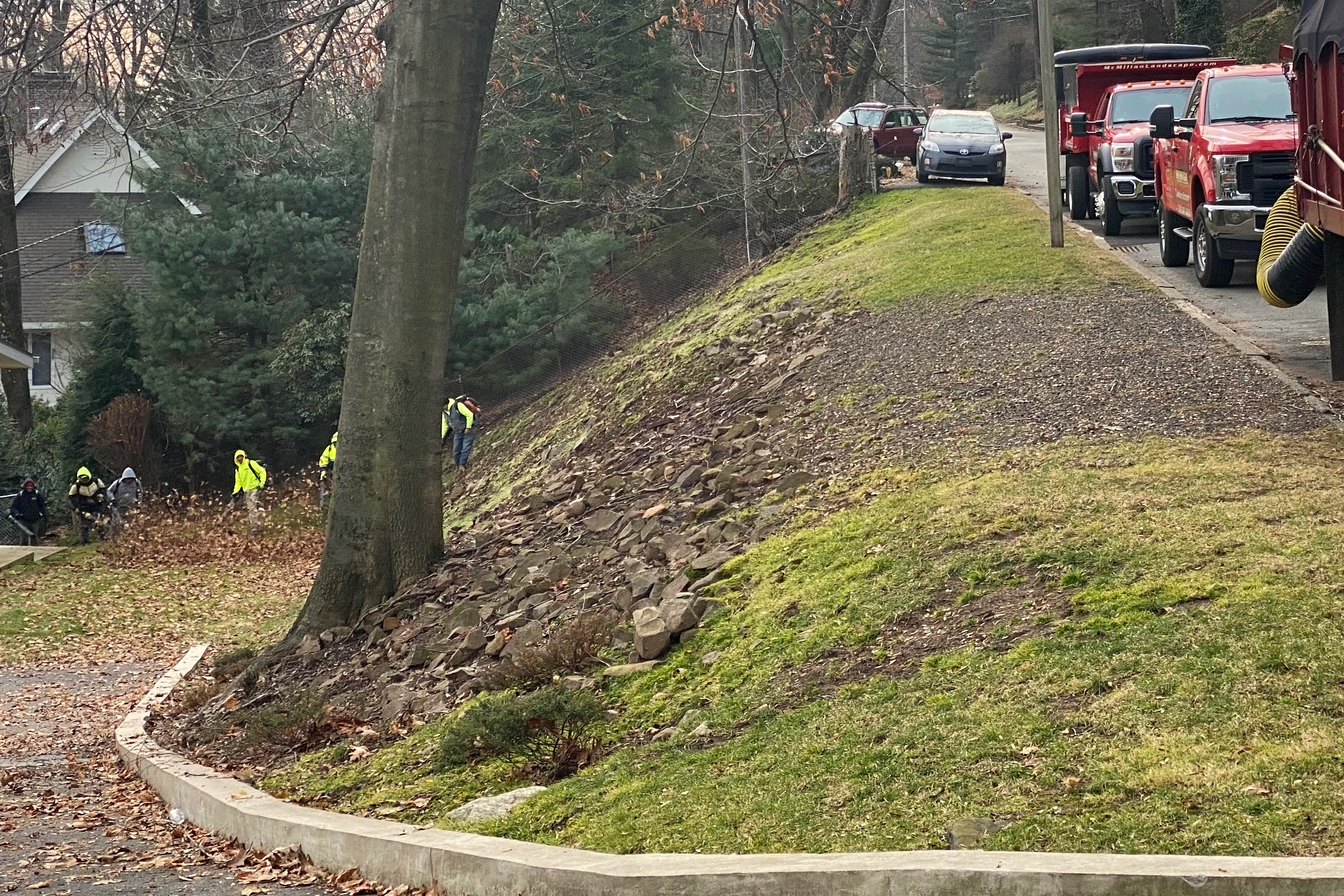
Now, I’ve mentioned this before, but it is a critical lesson. Leaves and fallen branches are not the enemy and when somebody shows up on your property with a leaf blower, it is clear evidence that they have no qualifications to be in the “landscaping” business. First, leaves are a free mulch, preventing opportunistic weeds from growing and retaining moisture. But more than that, removing leaves means interrupting the carbon cycle. The plant that dropped the leaves probably really likes whatever nutrients were in them. And in the case of deep-rooted plants such as trees, roots reach into layers of soil buried deep underground, accessing nutrients unavailable to plants with shallower roots. Far from being the bane of the suburbanite’s existence, leaves redistribute nutrients for those plants with shallower root systems. Moreover, as leaves decompose, they improve soil structure, thus increasing its capacity to retain moisture and support beneficial soil organisms. Adding broken-up sticks, rotting wood, and bark helps even further as all these encourage the growth of fungi producing mycorrhizae, symbiotic relationships between fungi and plant roots. In this partnership, as fungi colonize an area, they interact with the root system of a host plant, providing increased water and nutrient absorption capabilities to the plant. In return, the plant supplies the fungi with carbohydrates formed during photosynthesis. Mycorrhizae play a critical role in soil ecology, aiding plant growth and health, enhancing nutrient uptake, particularly phosphorus, and can also help plants resist pathogens and tolerate environmental stresses. Many woodland plants are dependent on mycorrhizae and will not thrive without them. Lycopods, for example, also known as clubmosses, are especially dependent on mycorrhizae and have a very difficult time surviving without them. Forget growing them in your urban or suburban garden (or even most labs for that matter)!
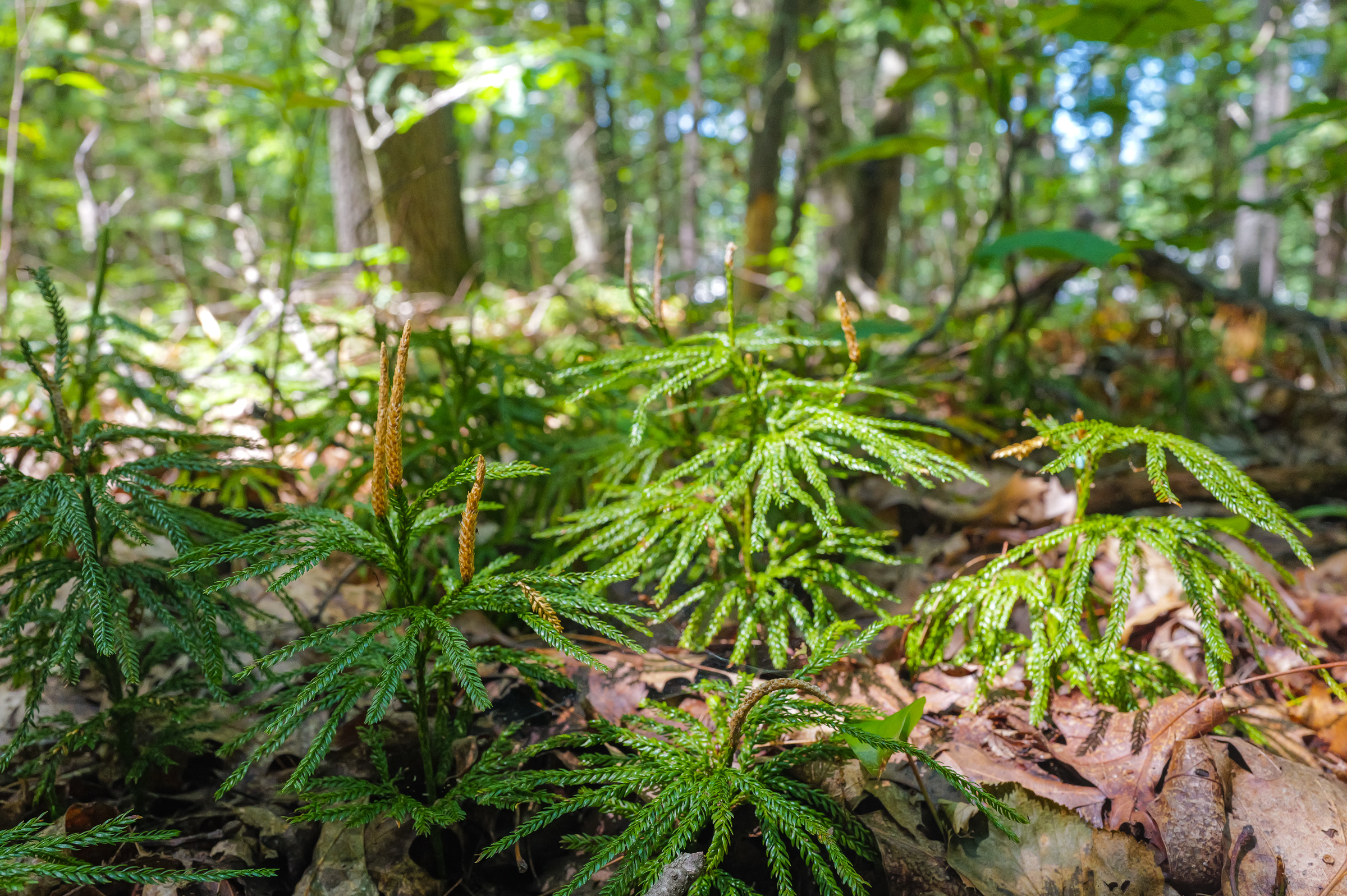
Going further into depth on soil is a matter for another time, but suffice it to say that the soil was poor and compacted, so I started with native trees—a Cornus florida, Flowering Dogwood, and a Cercis canadensis, Eastern Redbud—as well as a few bushes: Myrica penslyvanica, the Northern Bayberry, Rhododendron maximum, the Rosebay Rhododendron, and Kalmia latifolia, the Mountain Laurel. It took a bit of convincing on a family level, but eventually, I won out and left the leaves to decay on the ground below the trees that dropped them. We already had a large canopy of Liriodendron tulipifera, Tulip Poplars, Quercus borealis maxima, Red Oaks (the New Jersey state tree), and Fagus grandifolia, American beeches. But noting the complete absence of young trees on our property, I also issued an injunction that nobody in the family could “weed” trees that had naturally seeded themselves somewhere. Only a few years later, and with the addition of another Cornus florida and Cercis canadensis at the other end of the street-front, a rich understory of trees began to form.

As the soil structure began to improve and as I gained experience with native herbaceous perennials at the front of our house, I began to plant these as well. Observing that there are two moist spots at either end of the property, one shady and one sunny, I planted ferns such as Onoclea sensibilis, Sensitive Fern, Pteridium aquilinum, Bracken Fern, and other moisture-loving plants in the shady end, and a patch of meadow in the sunny area (see the featured image at the top of this post) where people often stop at to gaze upon the distant view of the city. Perhaps some of them will also look down and realize that the real beauty lies below them. By spring 2021, the front was advanced enough that it could be incorporated into a garden tour of the property for the Native Plant Society of New Jersey. In the space of a few years, an area of Highland Avenue was part of what Doug Tallamy calls the “Homegrown National Park.” My only real disappointment was that because many dog owners have no conception of property or nature, they would encourage Fido to do his business in the garden, leaving me to regularly find dog droppings as I gardened. While this might have some nutritive value for the soil, dog urine can also kill plants, and I certainly do not enjoy having to move someone else’s pet leavings to put in a new plant in so I wound up constructing a paracord and rebar fence to keep Fido and his owner on the street where they belong.
That fence, however, made me reluctant to take photographs of the area earlier and I only have this photograph from early September, 2021. How hard would it have been to remove the paracord or even just shoot with it in place as I did here? Well, I can also claim that the lighting is challenging in this shady area, and that much is true. In any event, here you can see exuberant growth in one of the relatively moist areas by the road. This area is visible in the photograph from July, 2016 as well, although it is in the distance, to the upper left of (and past) the leaning oak. It can also be viewed in 2013 on this Google Street View link.
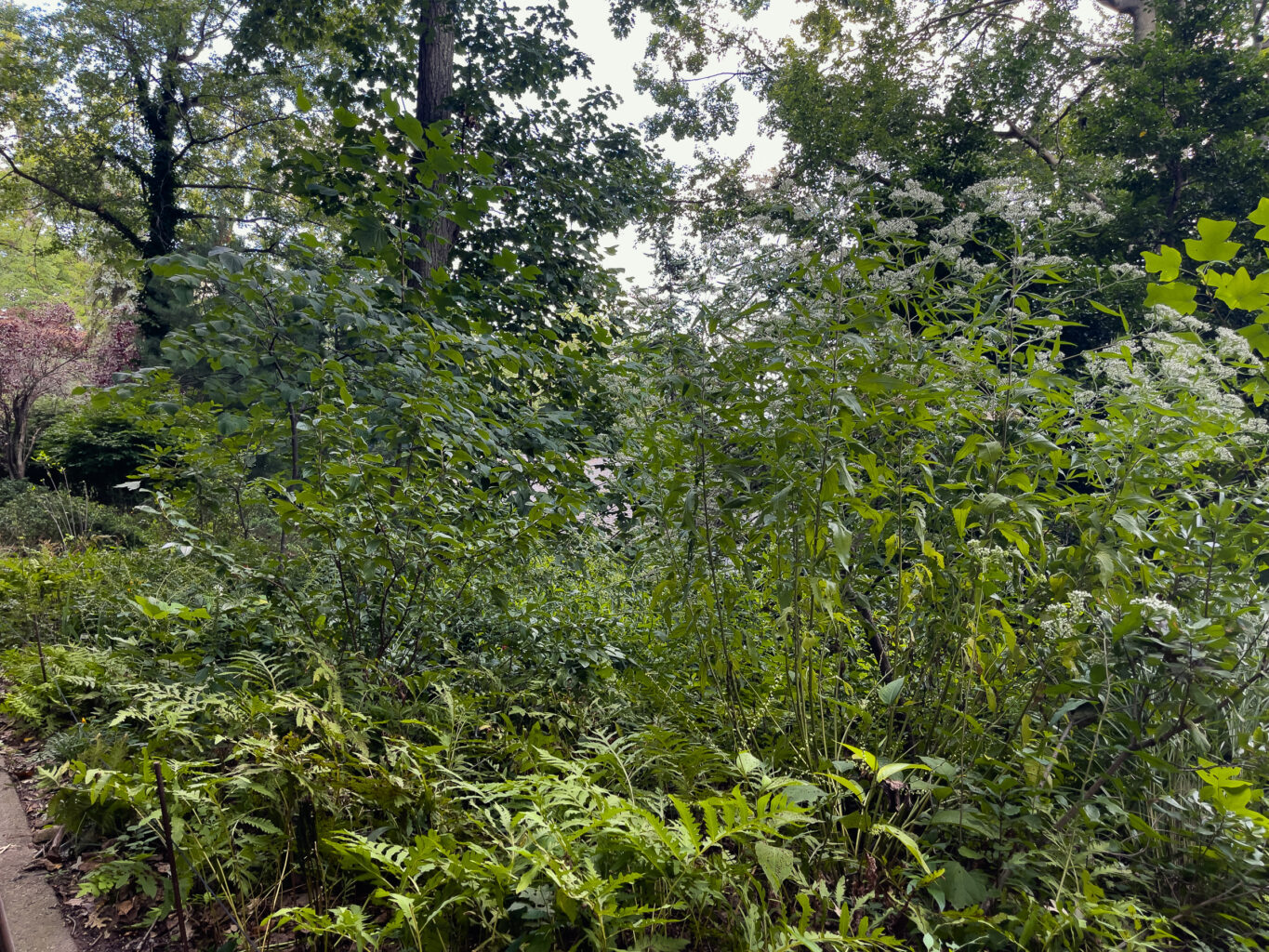
As everywhere else at Highland House, the planting is naturalistic: intended to look wild, but to avoid the extremes of the chaotic bramble or the barren forest floor. To that end, the composition here involved a steady increase in height organized in a series of “plateaus” the further one is from the road. At the front is Onoclea sensibilis, the Sensitive Fern, which never goes above 2′ in height. You can also see some Persacaria virginiana, the Woodland Knotweed or Jumpseed, in the lower middle of the photograph. This plant has slender stalks with tiny white flowers hanging off it. This is a beautiful plant, but I once made the mistake of buying what claimed to be the “Lance Corporal” cultivar, which had reddish-purple flowers and a chevron-marking on the leaves. I am strongly suspicious that this was not Lance Corporal, or if it was, that it was an Asian variant of Persacaria that is quite invasive. Years later, I am still weeding this stuff out, as it threatens to take over my garden, especially the lower reaches far from this spot. This plateau is followed by a taller plateau, even a wall of taller plants in the back such as the Eupatorium perfoliatum, Common Boneset, which—together with the trees and bushes—helps screen the road from our house, creating greater privacy for us.
Back to the present. Streetfronts are hard. I always knew the township’s schemes threatened this area, but I had hoped to get a little bit more warning. Four days was certainly insufficient, luckily, the contractors started on the other side of the street and snaked back to mine so by the time that they reached the property, I had moved the plants and the healthy soil, with its mycorrhizal riches far away. Digging and moving some 20 cubic yards of soil by hand was tough and time-consuming. As most of my property lies below the level of the road and there was nowhere to temporarily store it without the prospect of hauling it back up the steep hill in a wheelbarrow, so I wound up taking it on a one-way trip, dressing the more compacted areas in the back of the house, especially by the new pond, with it. We will see how well that works come the spring. This took weeks. Construction on our property began on December 6. I had a good conversation with the fellow in charge and he assured me he would be careful scooping out the soil with his earthmover and he did a great job. Unfortunately, the fellows who came by with their pickaxes were not educated and attacked a large number of remaining plants and roots with pickaxes.
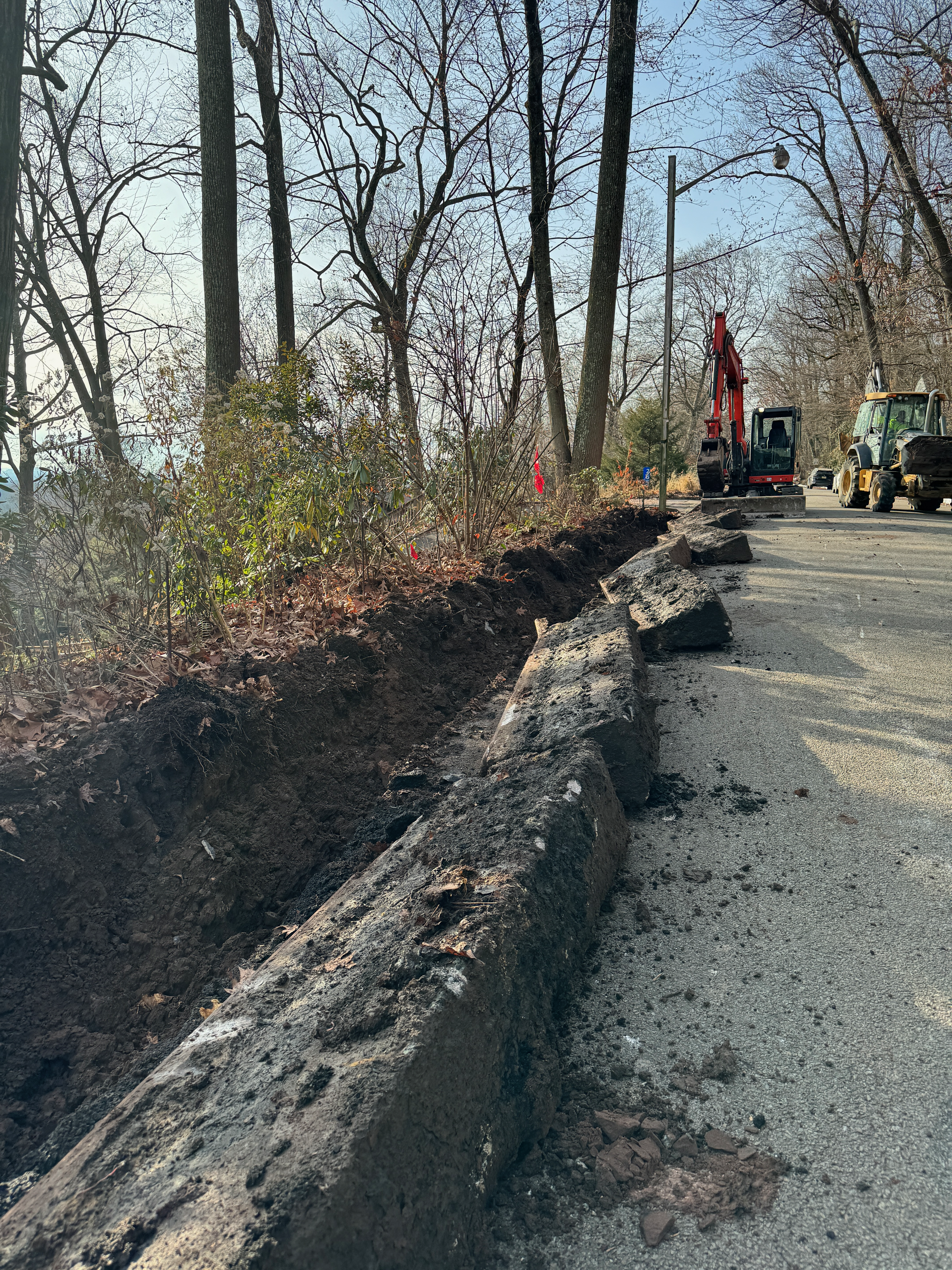
Note how dark and black the topsoil looks. Even with the road nearby, this is healthy soil, full of recently decayed organic matter and the large number of roots at the edge indicate how thriving this area was. As you can see in the Google Street View image from 2013, the soil at Highland House was reddish in color when we moved in. I’d never seen this in the Northeast and didn’t understand why this the soil was so red. But now I get it. Most places around here were constructed recently and excavated using heavy earth-moving equipment that strips away the topsoil. Red soil is not topsoil, it is a subsoil containing a high concentration of iron oxides that has not been properyl replenished due to years of leaves being removed by owners who fell for the scam of removing leaves. In just seven years of leaving leaves in my perennial beds, the soil looks completely different. Indeed, these appearances were confirmed by a cooperative extension test that indicated it was “beyond optimum” for most nutrients.
Within a week, the Belgian Block was in and the town backfilled behind it with inert topsoil of unknown origin. At least it wasn’t fill. Time to rebuild the soil again. But what about plants? Since is the street front, I need to get things in fast and, by chance, a brand new native plant nursery near me—Wildstead, in East Hanover —was having a preview sale so I went. It was a delight to talk with L.Be Sholar, the owner. She has an especially deep understanding of soil and we have come up with some strategies for bringing the inert soil to life quickly.
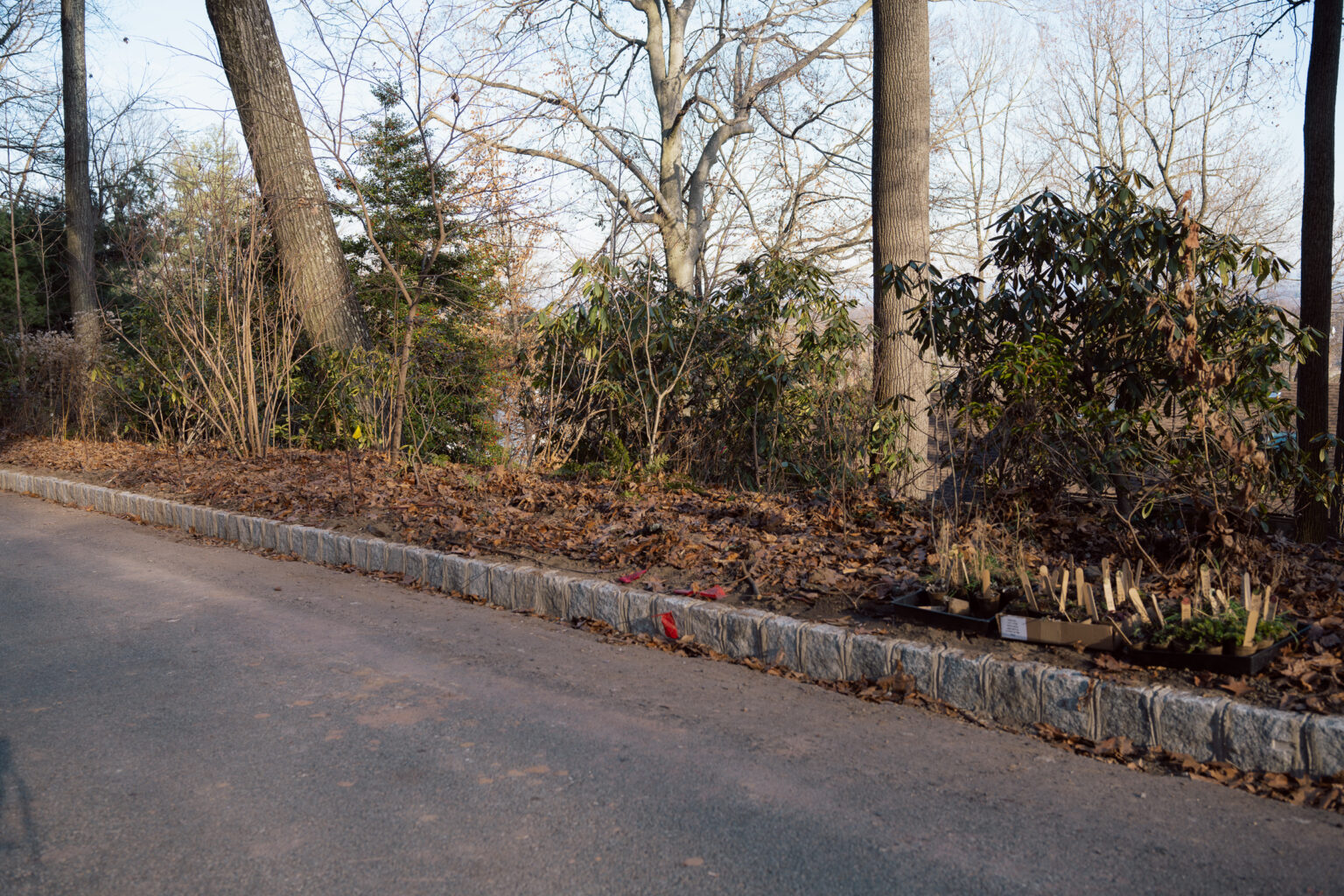
So the front looks ok, although it is definitely lacking many of the plants that made it unique and different and one of my signs explaining what this place is disappeared. They cost a lot, but I’ll have to buy a new one. I blew leaves all over the soil, broke up a bunch of bark and twigs and threw all that there. It’s time to e-mail L.Be and ask her for some of her family’s magic Organilock soil food to activate the soil here. It’s not expensive and it’ll be a good opportunity to try it out. Wildstead is a nice new store, well-designed, close to home, and full of natives. L.Be also has a landscape design business, creating native plant gardens and food forests. She started the store because she needed it for the business. This makes sense. Things are changing in the “Garden State.” This is good.